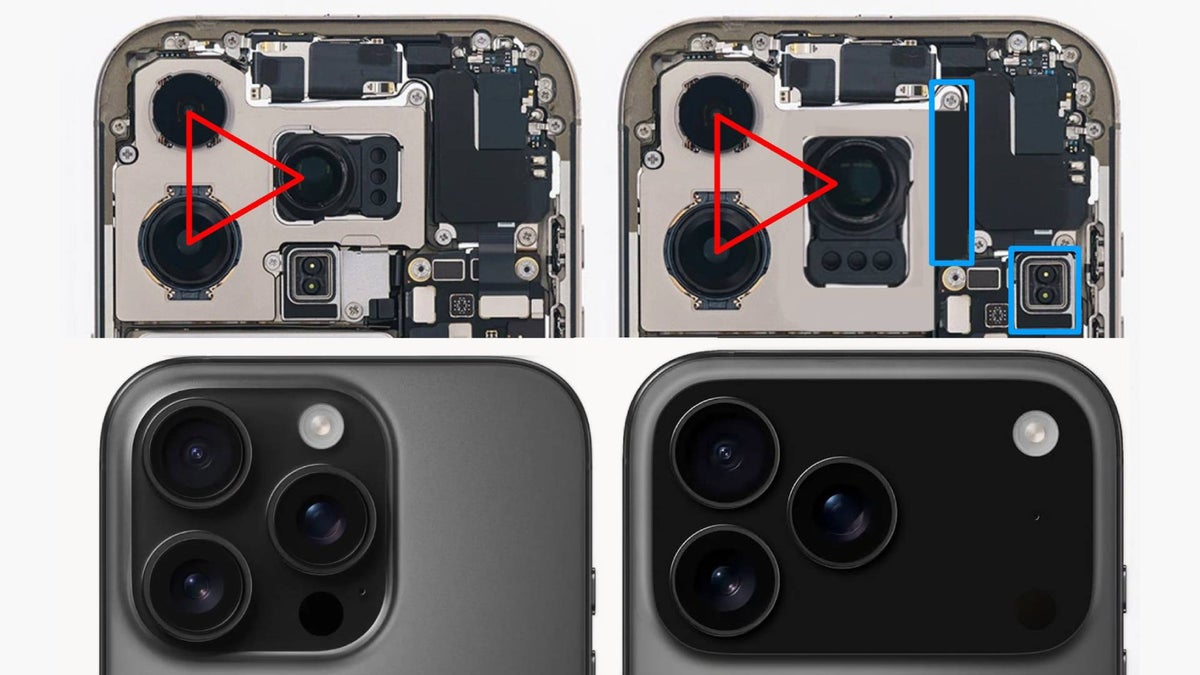The best image-stabilized binoculars in 2025
Want a powerful magnification and a judder-free image into the bargain? We round up the best IS binoculars you can buy…
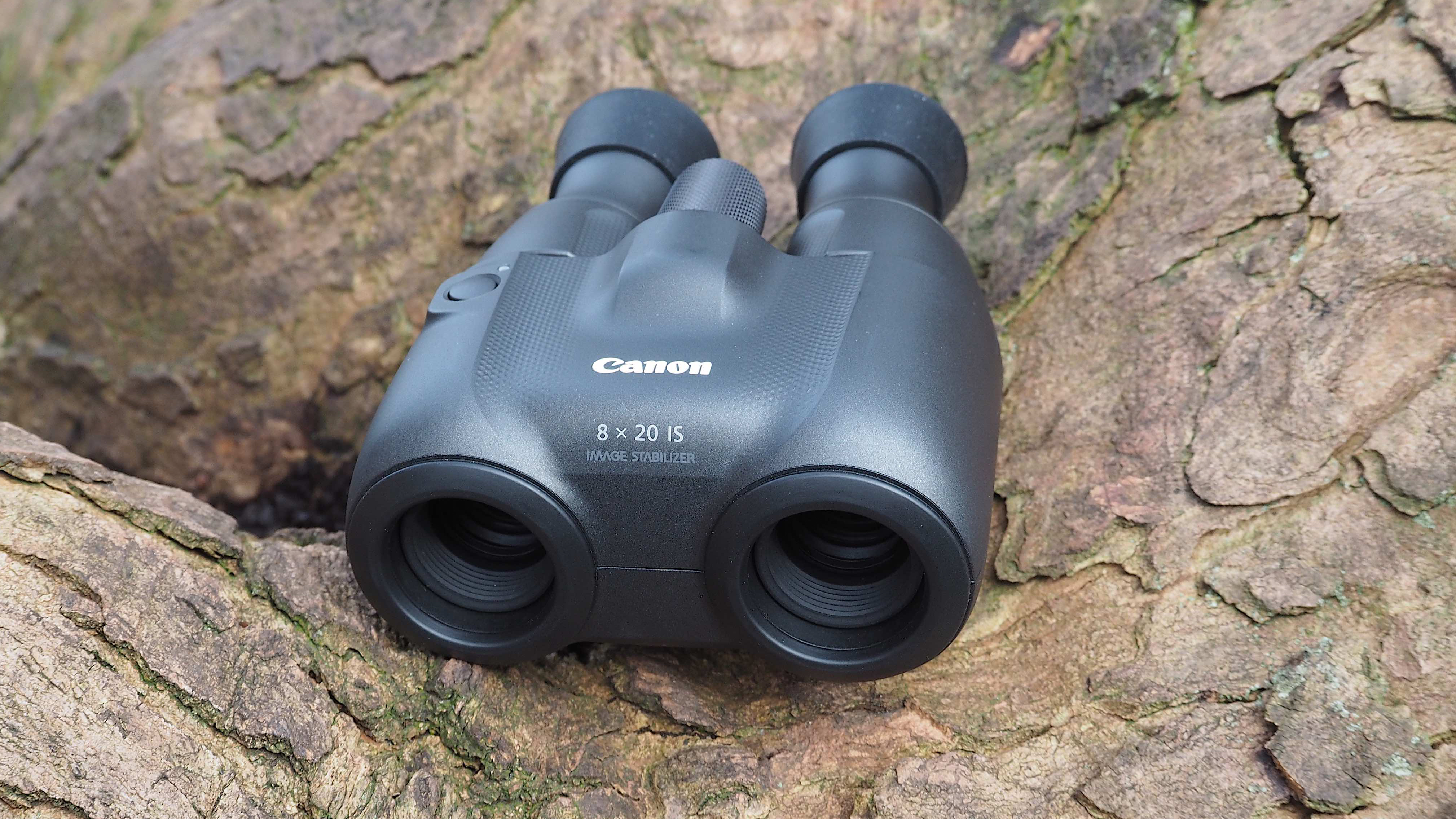
Looking for the best image-stabilized binoculars? This guide will help you find the perfect pair for your needs, and ensure you get the best price available.
The larger and more powerful the binoculars, the harder it is to keep them steady enough for a sharp, stable, and clear image. Image-stabilized binoculars address this issue by compensating for the natural movement of your hands.
This smart anti-shake technology uses built-in gyro sensors to detect and correct wobble. For avid wildlife watchers and nature enthusiasts, the benefits of image stabilization are well worth the slight premium that these models typically command.
Having built-in stabilization also means you don’t need to carry around a tripod—most binoculars don't even offer a screw thread for one. Additionally, image stabilization reduces eye strain, especially when observing distant subjects for long periods.
As with any binoculars, you'll also want to consider core features like magnification and objective lens size. Larger objective lenses generally provide brighter images, while greater magnification allows you to observe distant subjects more closely.
It’s true that higher magnification and larger lenses often result in bulkier binoculars, but the key is finding the right balance for the type of viewing you'll be doing. Higher magnifications can amplify any hand tremors, making image stabilization even more beneficial.
Now, let’s take a look at some of the top image-stabilized binoculars available right now...
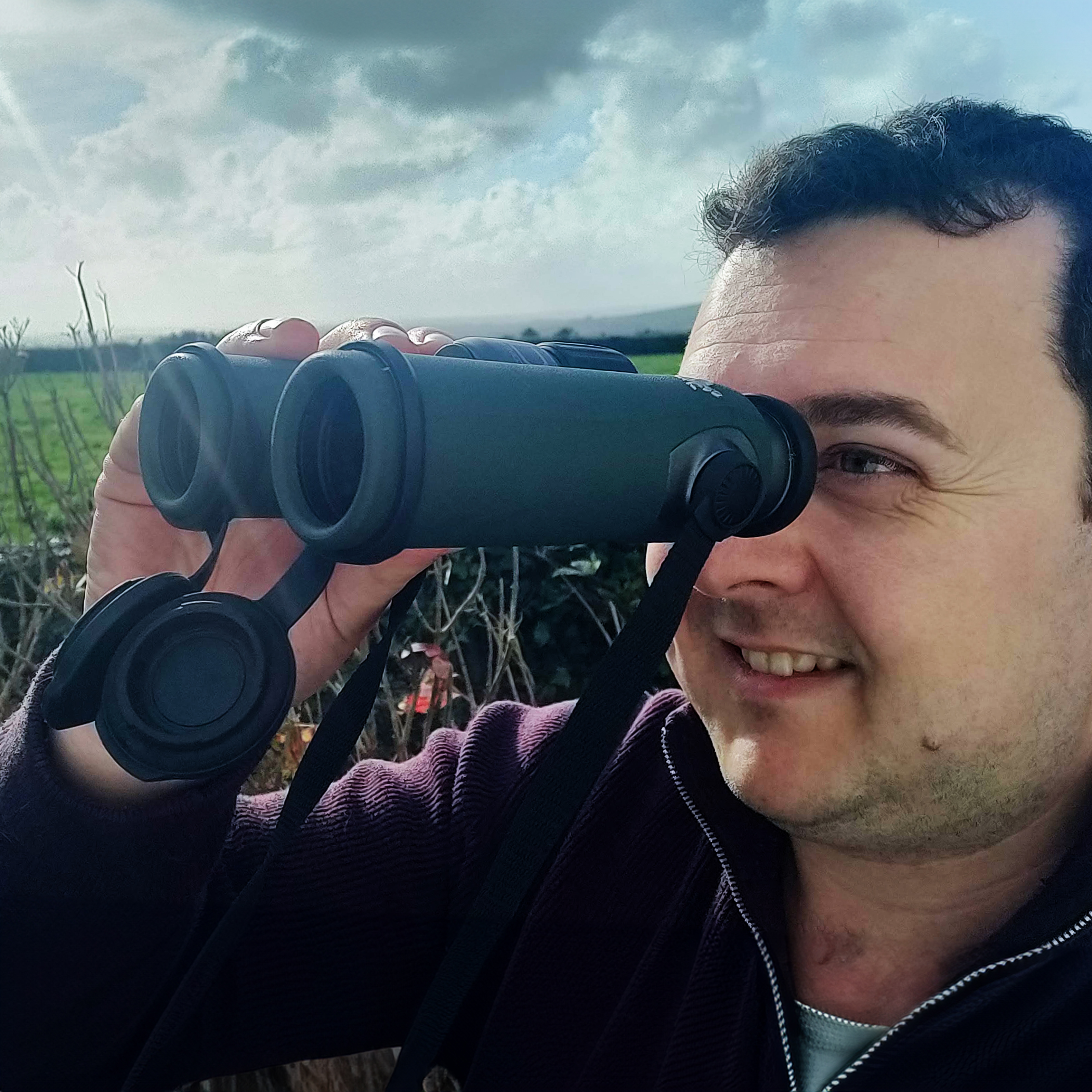
For nearly two decades Sebastian's work has been published internationally. As well as being a pro sports photographer he is also a big country sportsman who can be often found in or around the shooting field, sailing on the open sea, or taking part in other country pursuits, and quite often has either a pair of binoculars, a monocular or a scope in his hand.
Quick List

Canon is the leader in image-stabilized binoculars, and these are its premium pair with ‘L’ grade optical quality – denoted by a tell-tale red ring – matched to a large 42mm sized objective lens, making these great for low light.
Read more below
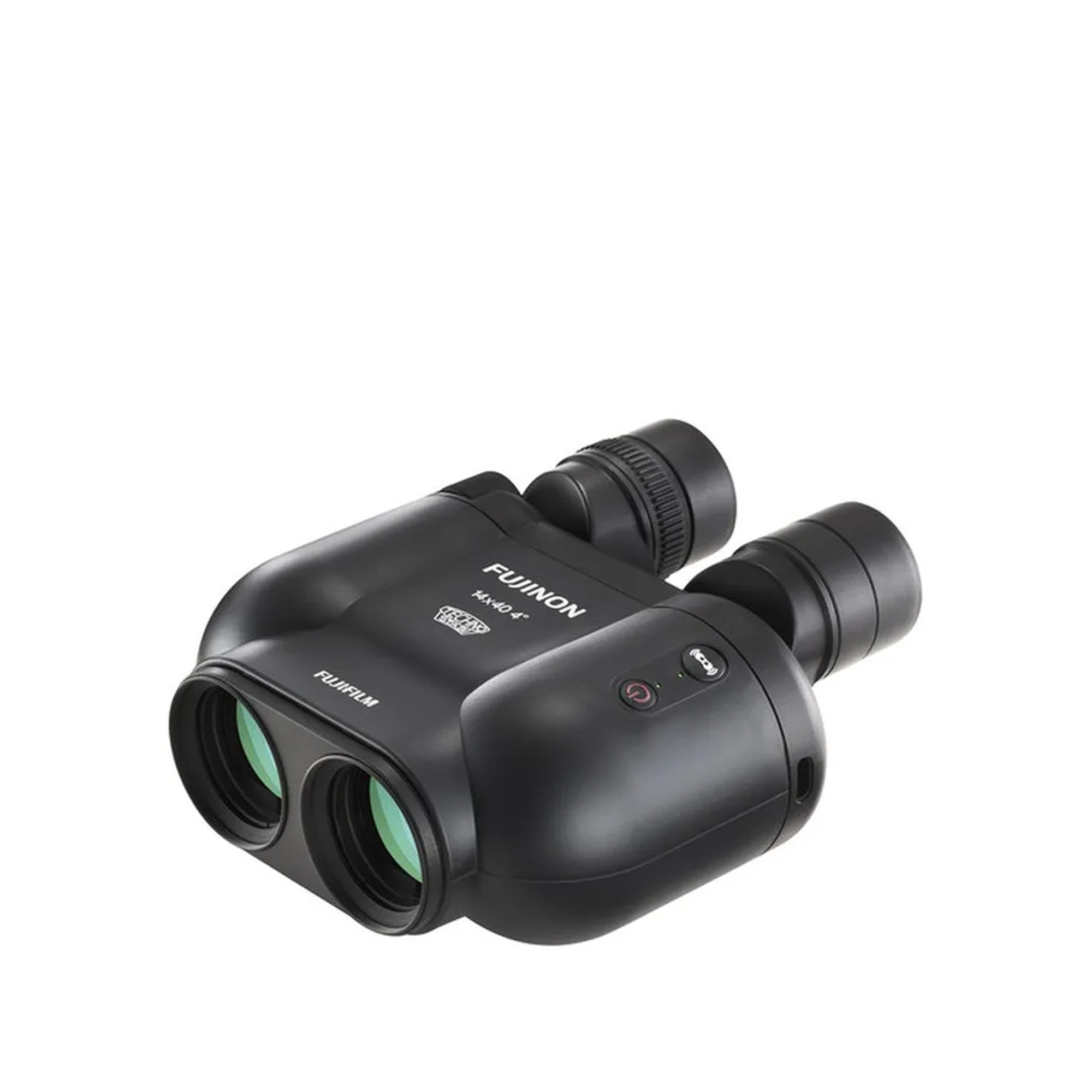
An upgraded pair of Fujinon branded binos from Fujifilm for the purists, with a powerful 14x magnification which is great for surveillance of a stationary subject - such as monitoring a nesting site.
Read more below
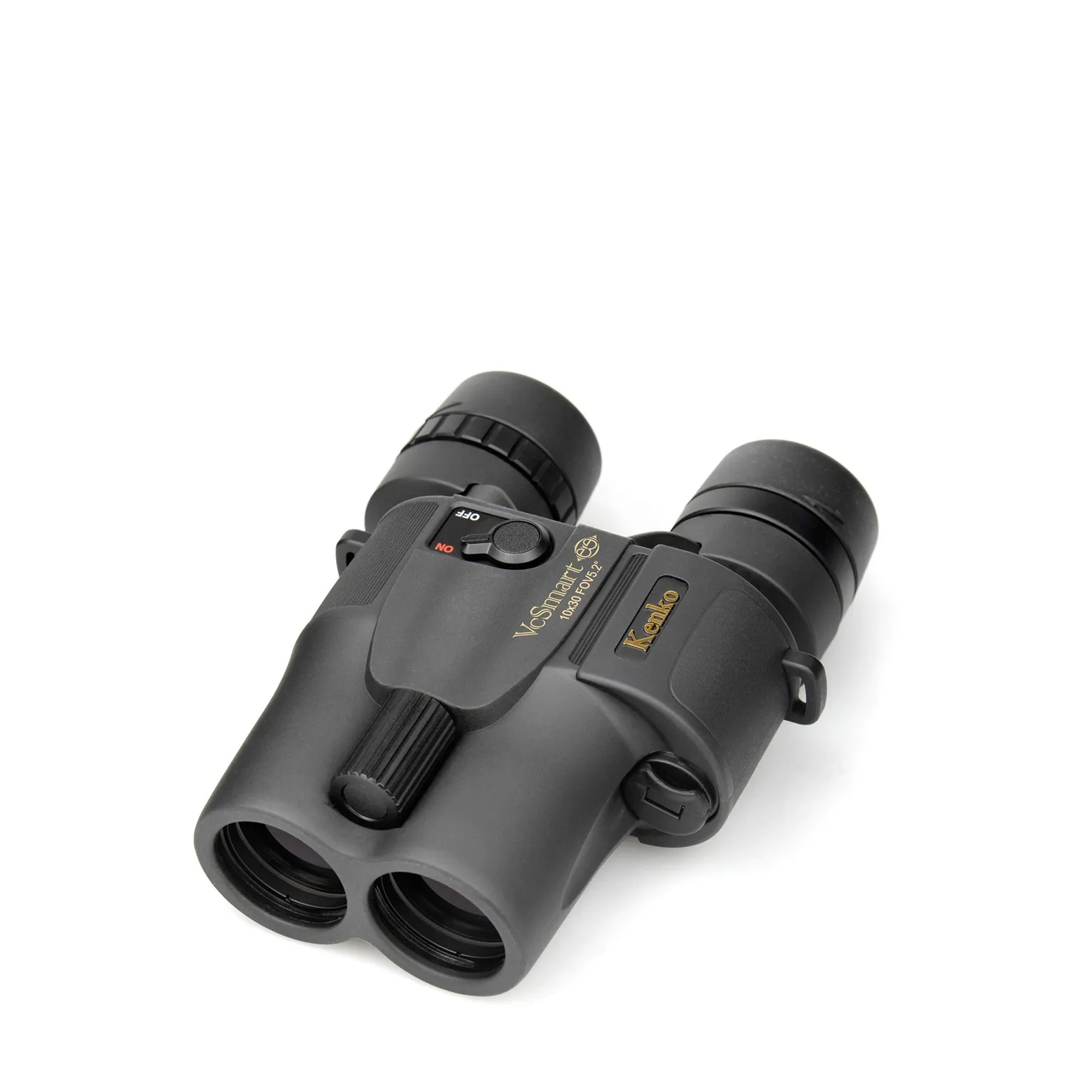
A compact and slender new binocular without the pedigree of a Canon, perhaps, but one that makes a claim for being the smallest pair of binos with image stabilization out there – with plenty more useful features besides.
Read more below
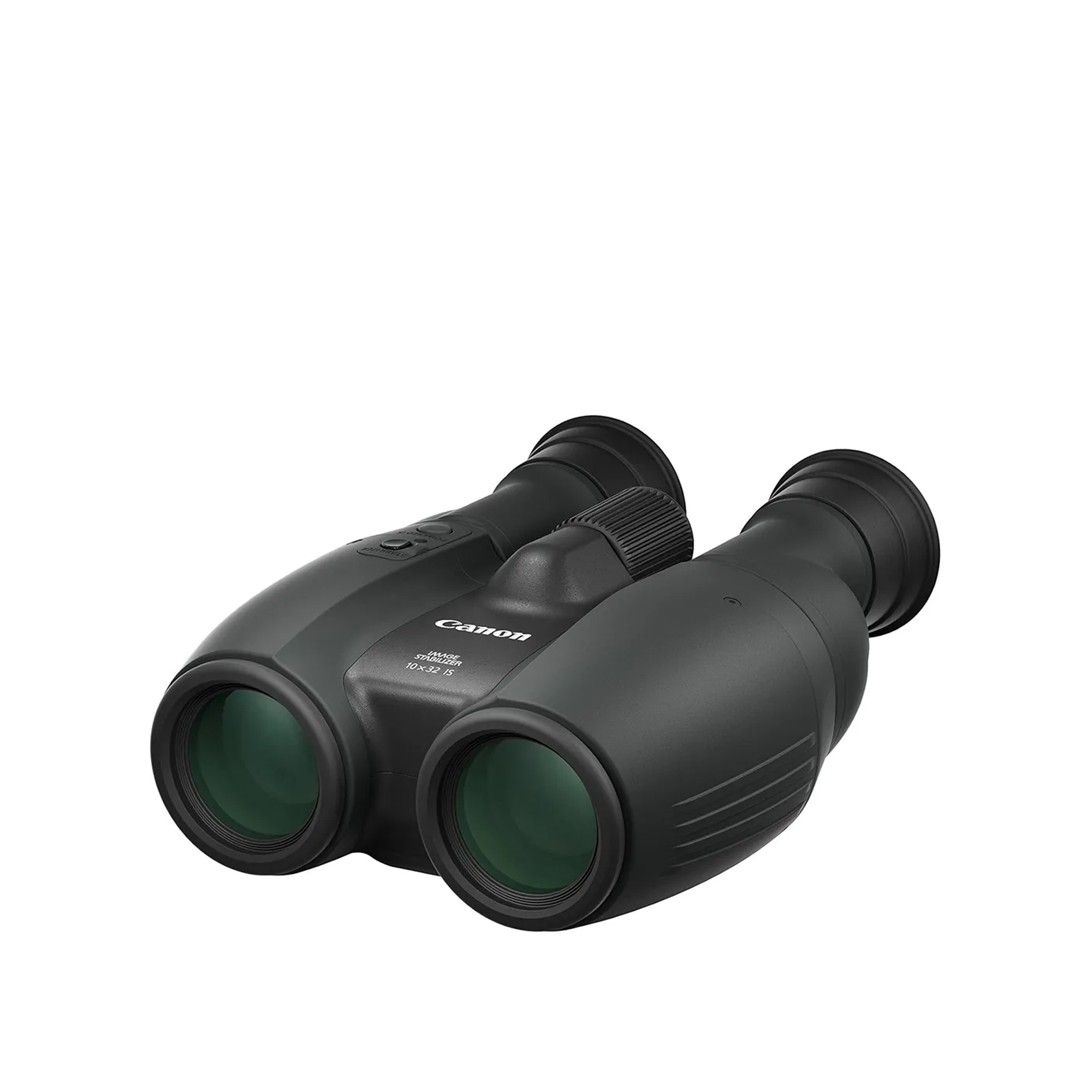
If you really want image-stabilized binoculars but want to try and save on the bulk, then these are a great compromise between magnification and image brightness - making them a great choice for all-round everyday use.
Read more below
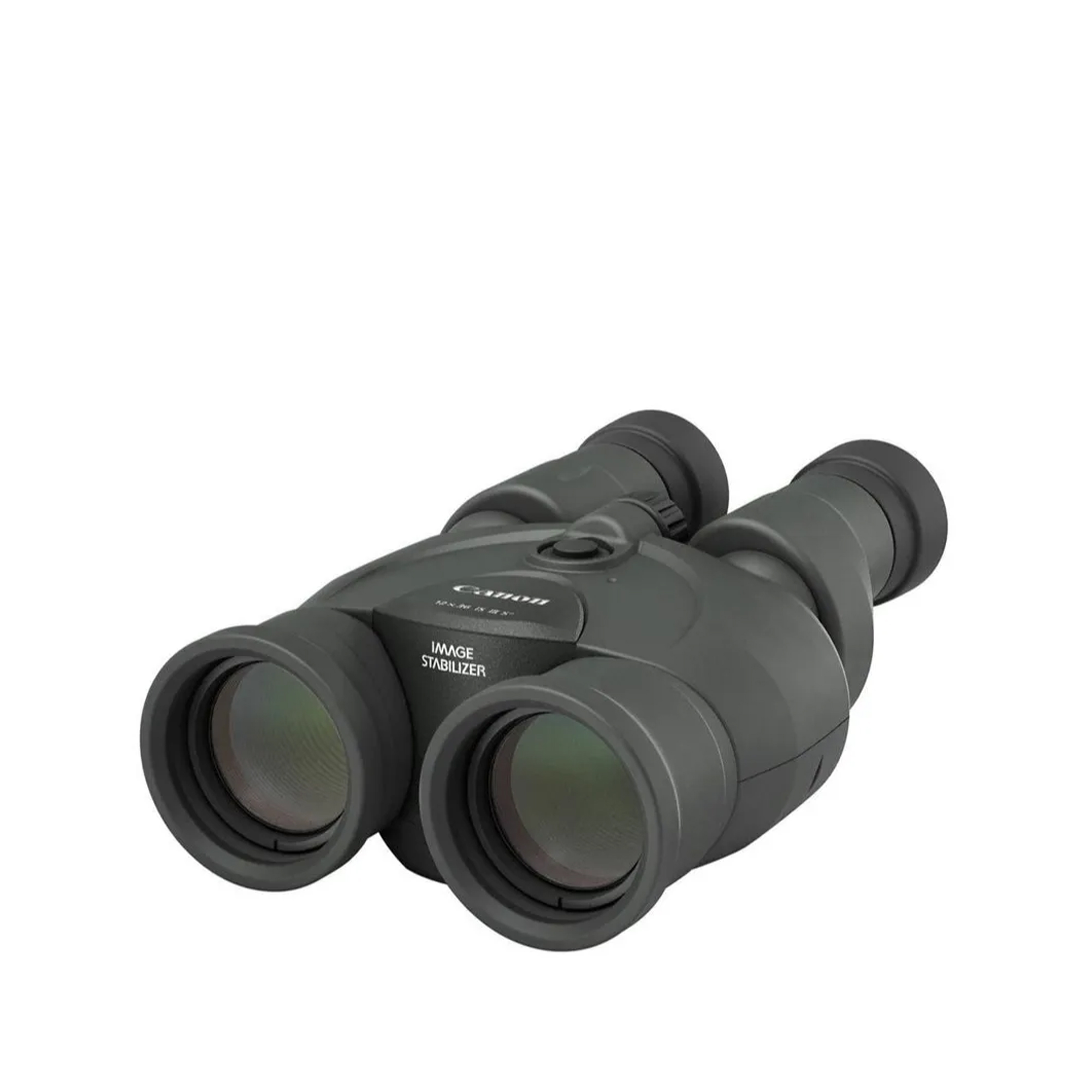
If you're a true twitcher and just love observing birds of all species these are the best for bird watchers on our list that offer IS and a high magnification.
Read more below
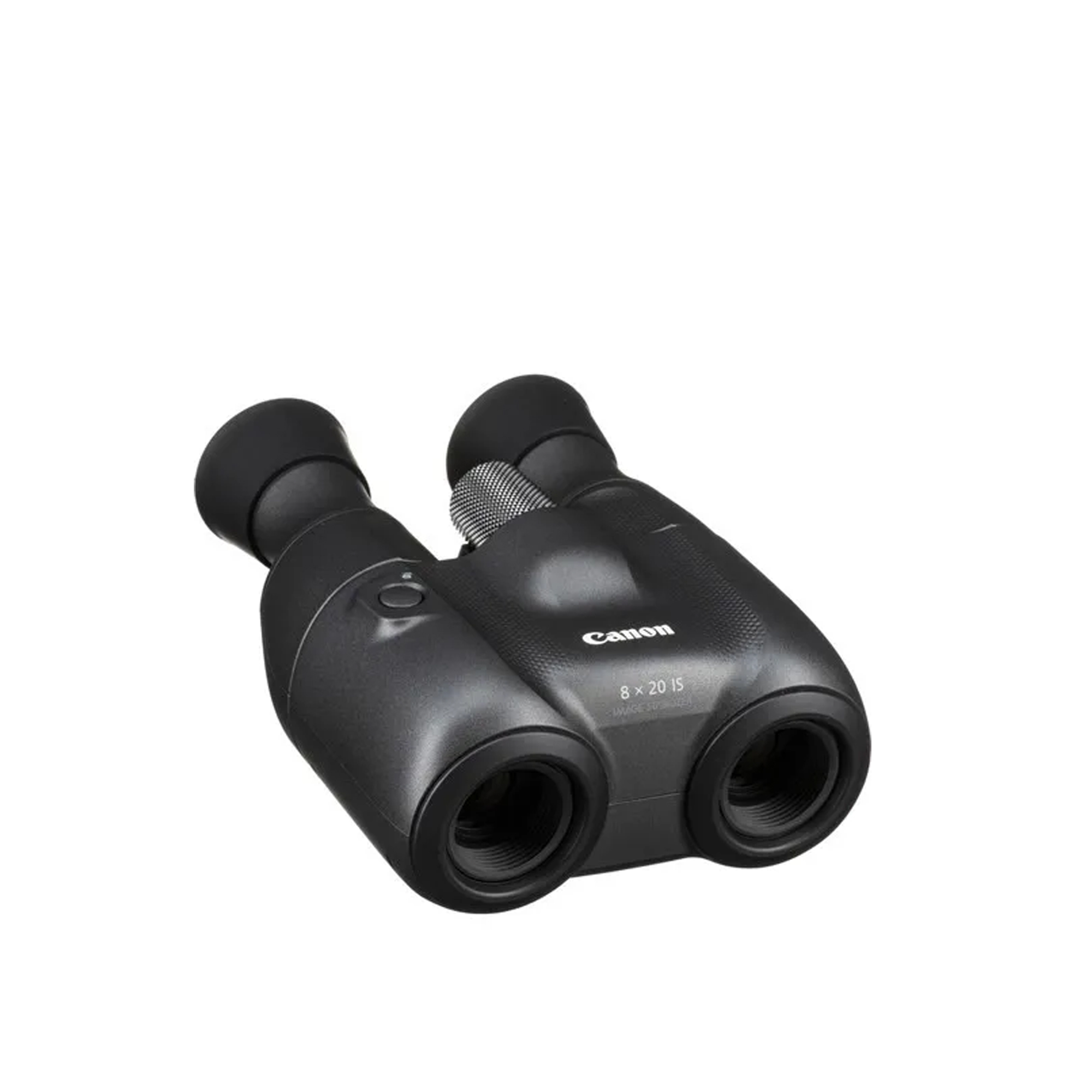
These are Canon's smallest and most affordable IS binoculars - making them a great choice for hiking, or for holidays. They don't give the brightest image, so best used in daylight.
Read more below
Best image stabilized binoculars
Why you can trust Digital Camera World
Best overall
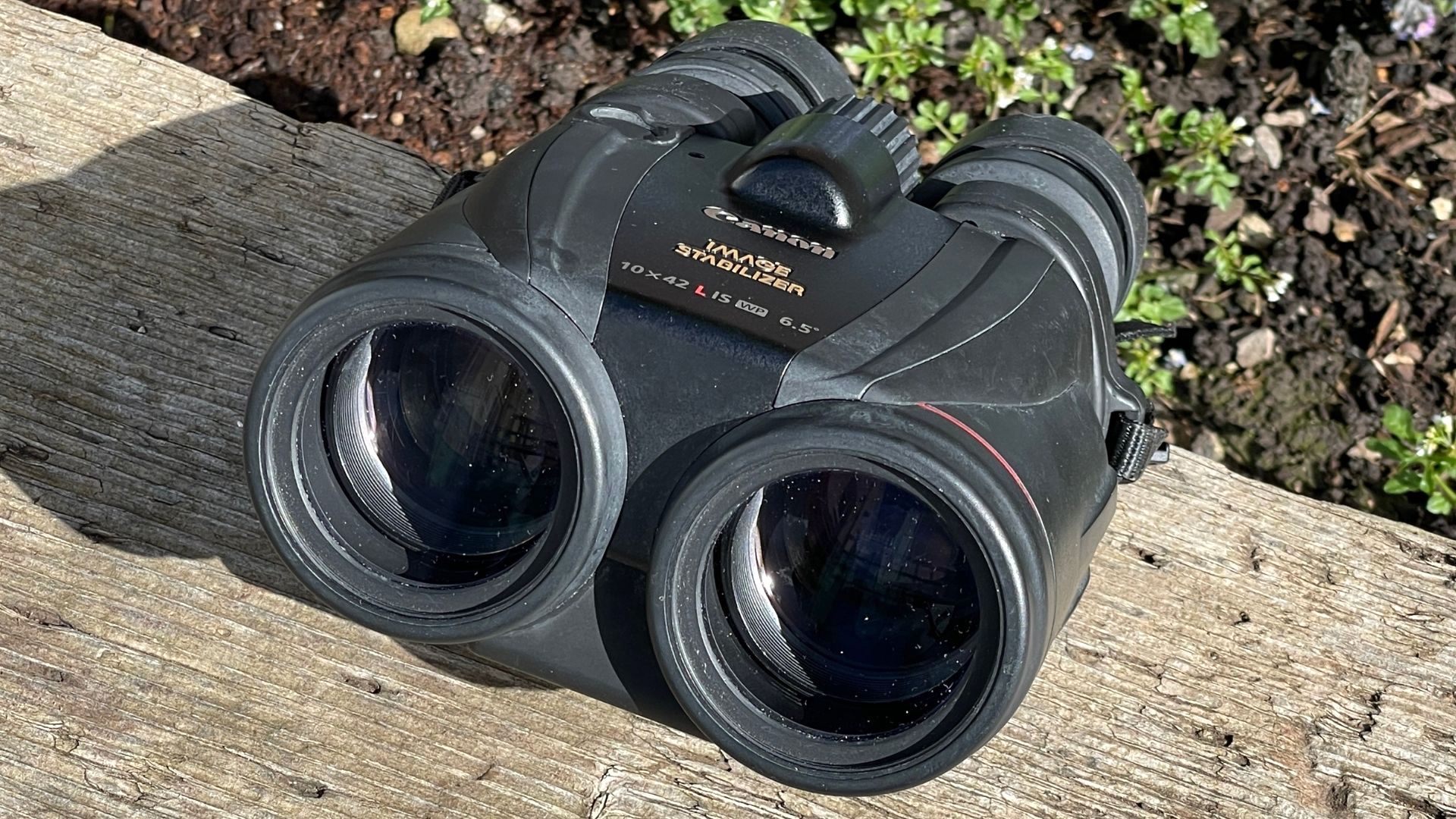

Specifications
Reasons to buy
Reasons to avoid
✅ You want the best: With its Vari-Angle Prism IS system these binos utilizes gyro sensors and micro-processor to give a rock-steady image
✅ You want rugged: being both waterproof and fog proof these binos are built to tackle any situation
❌ You're on a budget: these cost a fortune, so are out of reach for most of us
❌ You want something light: Due to their size and tech inside these are not the lightest around
As a binocular enthusiast, I’ve always been intrigued by Canon’s offerings—especially their top-tier ‘L’ grade optics, marked by the iconic red ring that signals exceptional quality. Combined with the sizable 42mm objective lenses, these binoculars promise outstanding visual clarity and performance.
Given the substantial price tag, it’s reassuring to know these binoculars are built to last. The O-ring sealing ensures reliable waterproofing, while Canon’s innovative image stabilization (IS) feature, powered by their Vari-Angle Prism system, uses advanced gyro sensors and microprocessors to keep your view rock-steady.
Other standout features include a comfortable 16mm eye relief, anti-fog technology, and a rugged, rubberized exterior that enhances durability. The wide 65° angle of view and a large 4.2mm exit pupil deliver bright, vivid views, even in challenging low-light conditions like dusk or dawn.
Sure, dropping over a grand on binoculars is no small decision. But the Canon 10x42 L IS WP binoculars deliver exceptional performance that more than justifies the investment—whether you’re stargazing, birdwatching, or exploring nature on either side of the Atlantic.
Read our full Canon 10x42 L IS WP binocular review for more details
| Row 0 - Cell 0 | Row 0 - Cell 1 | Score |
| Optics | For image stablized binos, there are the best in the business with crystal clear optics | 5 / 5 |
| Features | Image stabilization is the party pice with these binos, turning shaky observations into smooth, still viewing | 4 .5 / 5 |
| Value | Their cost is very high for most users, but you do get what you pay for | 4 / 5 |
Best for high magnification
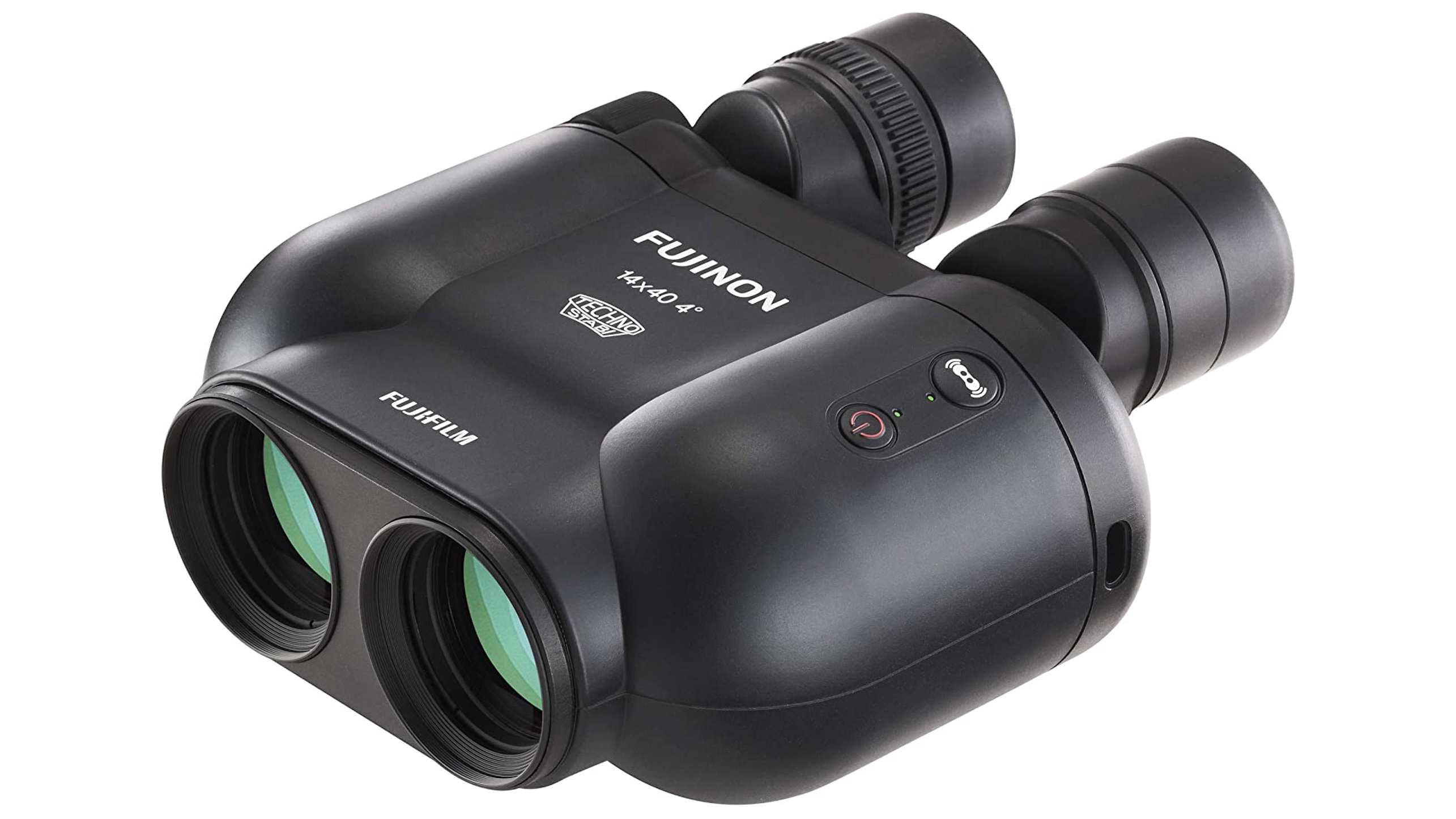
2. Fujinon 14x40 TSX image stabilized binoculars
Specifications
Reasons to buy
Reasons to avoid
✅ You want high magnification: with a lens set of 14x40 these are perfect if you want to observe far-reaching views
✅ You work on water: being waterproof and having a buoyant design means if the worst should happen they won't get damaged
❌ You don't like carrying: with a weight of 1.32kg these binos are very heavy to be carrying around all day
❌ You want close focusing: Unfortunately the closest you can actually see anything is 5 meters
I recently came across Fujifilm’s upgraded Fujinon binoculars, and as a purist, they immediately caught my attention. With 14x magnification and sizable 40mm objective lenses, they promise exceptional clarity and performance for a variety of viewing experiences.
What truly sets this new version apart is the improved stabilization range of +/- 6°, offering even steadier viewing compared to its predecessor. Another welcome upgrade is the use of rechargeable NiMH batteries, providing up to 12 hours of continuous use—ideal for extended observation sessions without the worry of frequent replacements.
The binoculars employ optoelectronic image stabilization paired with vibration suppression technology, ensuring your views remain sharp and shake-free. An automatic power-down feature further extends battery life by switching off the binoculars when idle, a thoughtful touch for practical use.
In terms of design, the curved exterior offers a comfortable grip, while twist-up eyecups and fog-proof construction enhance usability in various conditions. Although they weigh in at 1.32kg, making them the heaviest option I’ve come across, the added heft is mitigated by the included carry case and strap, which makes them easy to transport.
What really caught my attention, though, is their exceptional waterproofing. Not only can they withstand exposure to the elements, but they’ll actually float if dropped overboard, an impressive feature for anyone using them on or near water.
While the price is undeniably steep, the combination of advanced stabilization, premium optics, and rugged durability makes these binoculars a worthwhile investment for serious nature observers and sports enthusiasts alike.
| Row 0 - Cell 0 | Row 0 - Cell 1 | Score |
| Optics | With their high magnification these optics are crystal clear giving you the best chance to observe wildlife from far away | 4 / 5 |
| Features | High magnification, heavy-duty waterproofing, and solid construction make these a brilliant choice for all weather conditions | 4 .5 / 5 |
| Value | You get what you pay for, but these could be out of reach for most | 3.5 / 5 |
Best budget
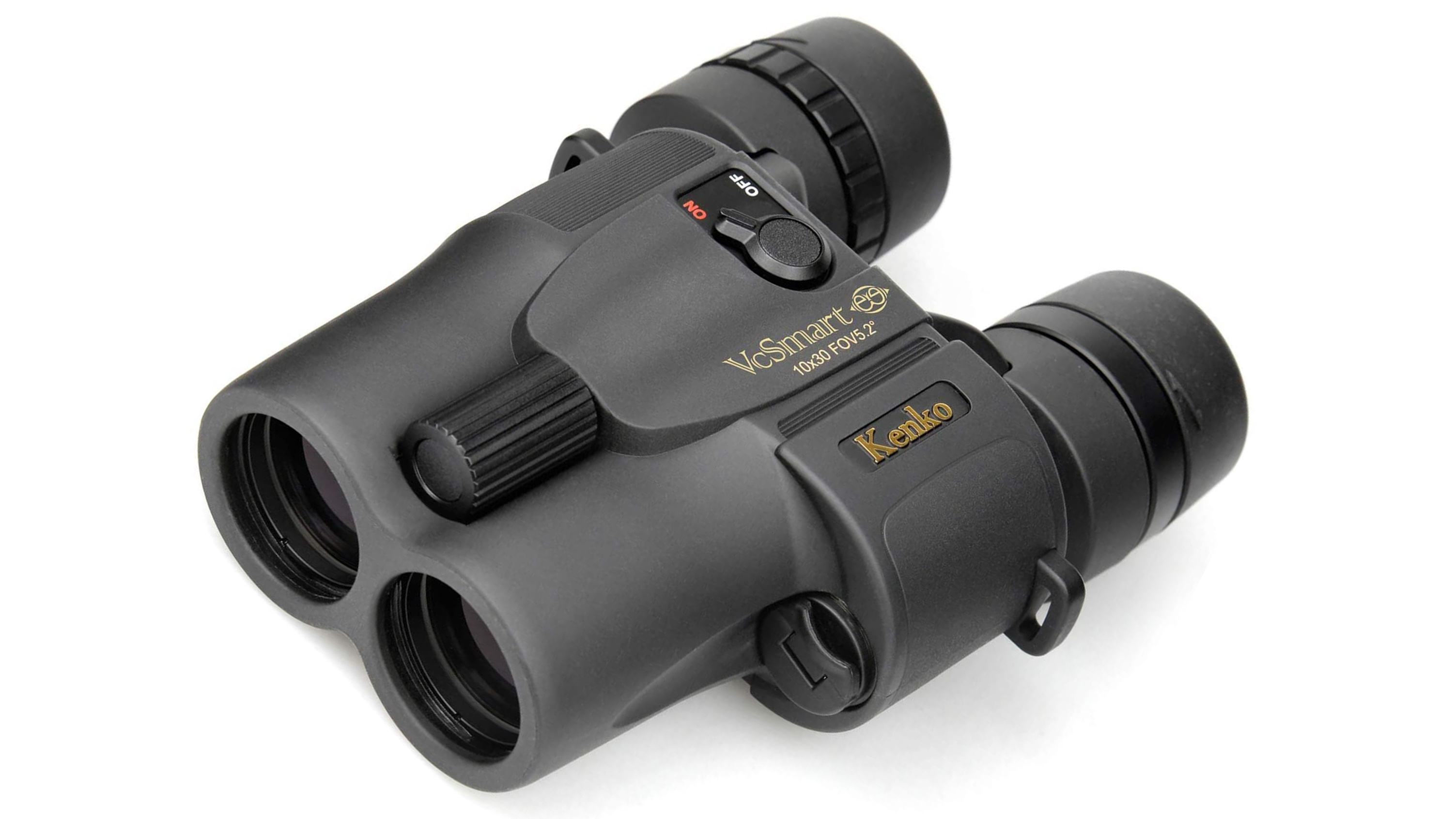
3. Kenko VcSmart 10x30
Specifications
Reasons to buy
Reasons to avoid
✅ You're on a budget: Under £500 / $500 these are the best budget stabilized binos available
✅ You want control: these have the ability to turn the image stabilization on of off, whenever you want by a click of a button
❌ You want waterproofing: saving cost means that waterproofing has been missed on these binos
❌ You want a 'main' brand: while these are great binos, they are not from a major manufacturer
This new binocular model may not carry the same pedigree as a Canon, but it’s making a strong case as one of the smallest pairs of binoculars with image stabilization on the market—packed with a variety of other useful features to boot.
The standout feature is, of course, the built-in image stabilization, which ensures steady views even without a tripod. In addition, the fully multi-coated lenses improve light transmission and maintain true color fidelity for clear, vibrant images. With a 5.2° field of view, these binoculars weigh just over half a kilogram, slightly heavier than some Canon competitors, but still quite portable. They also feature twist-up eyecups, offering comfort for users, especially those who wear glasses.
Beyond the stabilization and vibration control—which can be easily activated or deactivated with a simple lever—this model offers 10x magnification paired with a 30mm objective lens. This places it comfortably in the middle of the range of binoculars with similar specs.
To make the deal even sweeter, the binoculars come with a carry case and strap straight out of the box—making them ready to go as soon as you are. Now that’s smart.
| Row 0 - Cell 0 | Row 0 - Cell 1 | Score |
| Optics | With fully multi-coated optics and long eye-relief make these outstanding optics for the price. | 4 / 5 |
| Features | With a solid construction this pair is perfect for those on a budget | 5 / 5 |
| Value | For the price, these are the best IS binos around for an affordable "entry level" price | 4.5 / 5 |
Best for everyday use
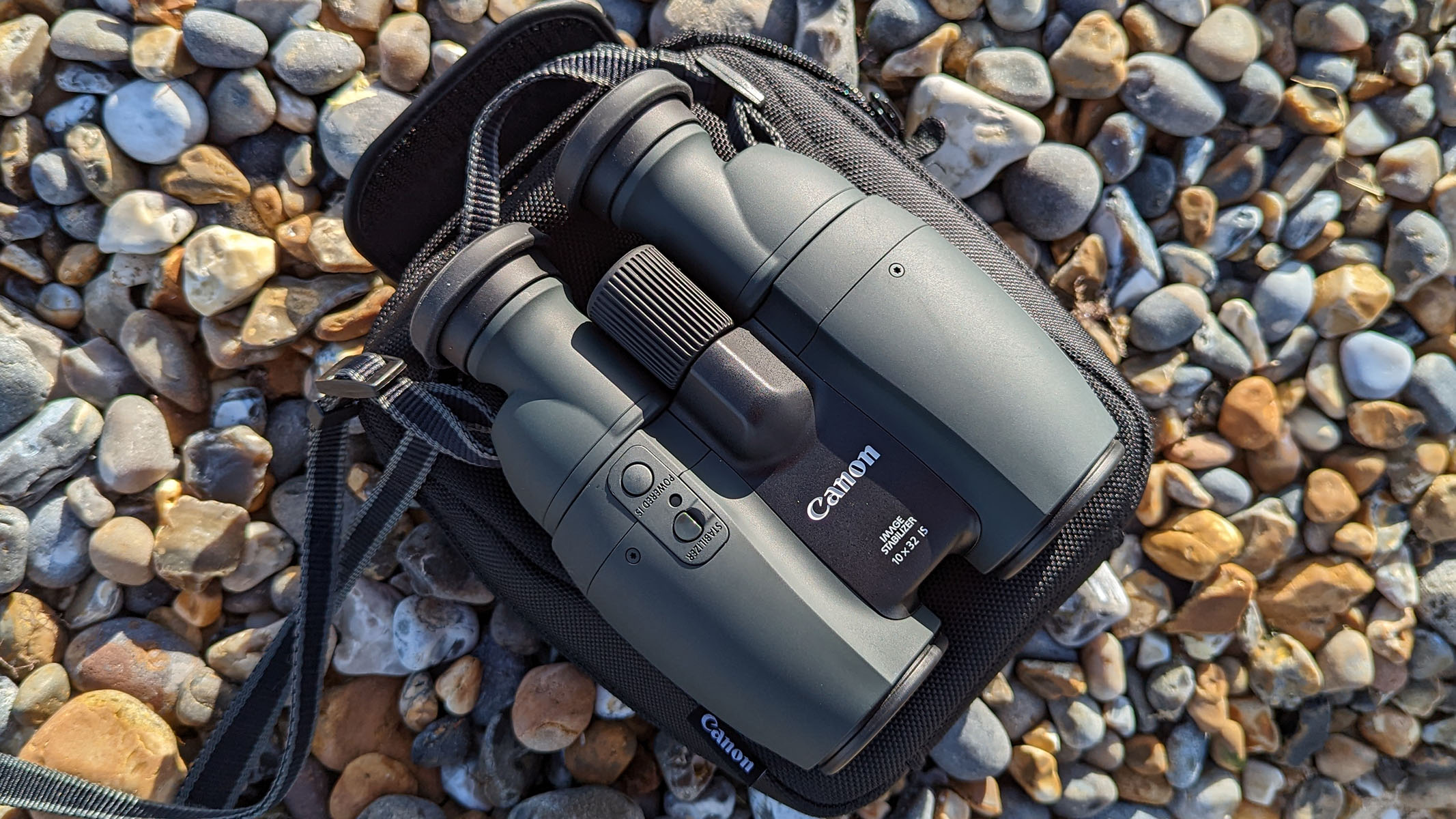
Specifications
Reasons to buy
Reasons to avoid
✅ You want a main brand: Canon is the king of IS binos at the moment and that means something
✅ You want rugged: these binos offer a durable and robust construction
❌ You want anti-fog: No Nitrogen-purging present leads to fogging of the lenses
❌ You want great optics: these binos do suffer from color fringing around contrasted edges
These stabilized binoculars offer a significant advantage to observers by providing steady, lifelike views that are beautifully magnified. During our review, we found ourselves reluctant to put them down, fully immersed in the experience.
However, there are a couple of issues worth mentioning, primarily due to the price. Specifically, chromatic aberration and lens fogging were noticeable.
While we believe these problems shouldn’t be present at this price point, they don't detract from the overall enjoyment of using these binoculars. If you’ve never tried image-stabilized binoculars before, be prepared—once you experience them, it’s hard to go back.
If you can afford the investment and the occasional fogging doesn’t bother you, this pair is a fantastic choice.
Read our full Canon 10x32 IS binoculars review for more details
| Row 0 - Cell 0 | Row 0 - Cell 1 | Score |
| Optics | Color fringing around the edged and no anti-fogging layer means these are not the best of the bunch | 3.5 / 5 |
| Features | Image stablization is solid offering shake-free images and its rugged exterior make these a good option for everyday use | 4 / 5 |
| Value | These are a little pricey when compared to others on this list | 3.5 / 5 |
Best for bird watchers
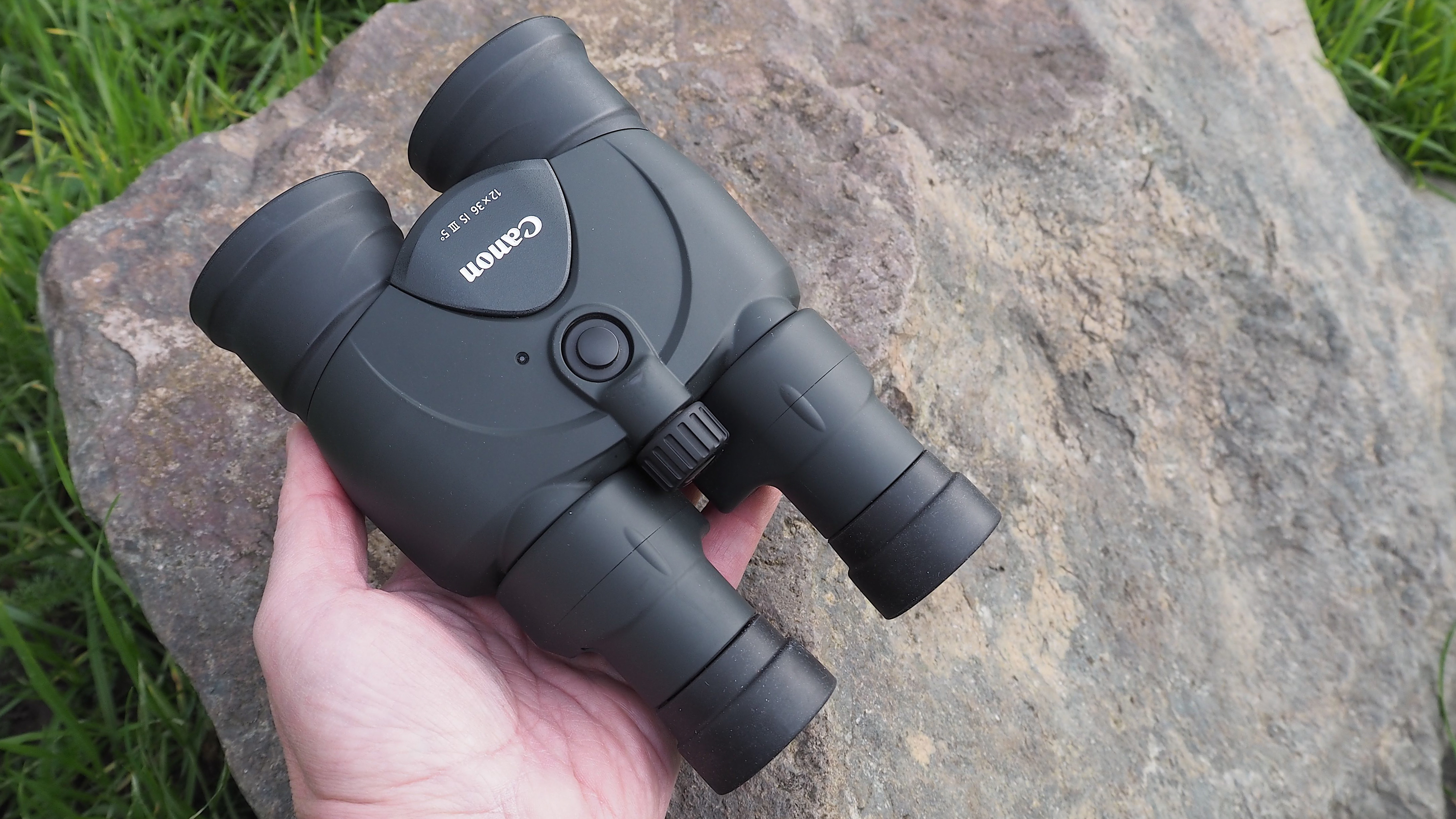
Specifications
Reasons to buy
Reasons to avoid
✅ You want to use on the move: with powerful image stabilization these are perfect to use while on the move on safari
✅ You want rugged: being both waterproof and fog proof these binos are built to tackle any situation
❌ You want weather proofing: with the cost, we'd expect these to offer better weather-sealing.
❌ You want long battery life: its 9-hour battery life from two AA batteries is ok, but I'd like to see better
Canon’s 12x36 image-stabilized Porro prism binoculars strike the perfect balance between powerful 12x magnification and a 36mm objective lens, offering clear, edge-to-edge views that are ideal for both birdwatchers and sports enthusiasts.
The anti-shake system, which combines gyro sensors and a microprocessor, ensures a steady image—even when viewed from a moving vehicle. Plus, the batteries can last up to nine hours of continuous use, providing long-lasting performance.
These binoculars feature the same Super Spectra lens coating found in Canon's EF camera lenses, enhancing resolution while minimizing distortion, ghosting, and scattered light for sharper, more accurate views.
For comfort and ease of use, the binoculars are coated with a rubberized exterior, providing a secure grip. The image stabilizer button and focus knob are conveniently positioned for quick access and smooth adjustments, ensuring a responsive experience.
Overall, these binoculars are exceptionally well-specified, offering great value for those seeking high-quality optics with advanced image stabilization.
See our full Canon 12x36 IS III review
| Row 0 - Cell 0 | Row 0 - Cell 1 | Score |
| Optics | Good clear optics that offer great viewing for a number of wildlife observations | 4 / 5 |
| Features | You can use these from a moving car and still get a steady image, but the lack of waterproofing can put some off, but it does cut the price down a little | 4 / 5 |
| Value | I'd say if you want some IS binos for safari these are a great option, but they are best in dry environments | 4 / 5 |
Best image-stabilizing binoculars for travel

Specifications
Reasons to buy
Reasons to avoid
✅ You're on a budget: at under £500/$500 these are great from a main brand
✅ You want 'compact': suited to a more compact environment their size and weight is suited to everyday use
❌ You want AA batters: the Image stabilization feature requires the use of an optional CR123A battery!
❌ You want to use all the time: Due to its magnification set I would suggest optimal viewing in the day time
Canon's image-stabilized Porro prism binoculars prove that not all stabilized models are bulky or heavy. This compact pair combines 8x magnification, a 20mm objective lens, and a lens-shift shake reduction system into a lightweight 420g design, making it perfect for travel and everyday use.
While the image stabilization—borrowed from Canon’s RF and EF camera lenses—is a standout feature, it’s not the only thing that ensures sharp, clear views. The Super Spectra Coating on the glass enhances contrast and reduces glare, further improving image quality.
A tactile focusing wheel sits conveniently between the adjustable eyecups, allowing for easy adjustments without taking your eyes off the subject. A dioptric adjustment is also included, making these binoculars ideal for spectacle wearers.
The CR123A battery, which powers the image stabilization, offers up to 12 hours of use, though it must be purchased separately. And while these binoculars may come at a higher price than non-IS models with similar specs, they are Canon’s entry-level option in their lineup—a solid choice for anyone looking to start with premium image-stabilized optics.
Read our full Canon 8x20 IS review
| Row 0 - Cell 0 | Row 0 - Cell 1 | Score |
| Optics | the small size of the lens set means that these are best suited to daytime viewing,they are very good in the daytime but lack very bright lenses | 4 / 5 |
| Features | The smallest and most compact IS binos around these are perfect to have on you all the time or to store in are bag or car. However thier lack of waterproofing does restrict usage | 4 / 5 |
| Value | For under $500/£500 and the features they offer I'd say they are a good investment for those wanting compact IS binos | 4 / 5 |
How we test IS binoculars
In our buying guides, we focus on binoculars with image stabilization that are well-constructed and built to endure the rigors of everyday birdwatching and wildlife observation, all while delivering a steady, judder-free view thanks to the integrated IS.
We also prioritize magnification, offering a wide range to cater to different preferences. Budget is another key consideration, so within this guide, you'll find options that meet both your financial needs and performance expectations.
How to choose
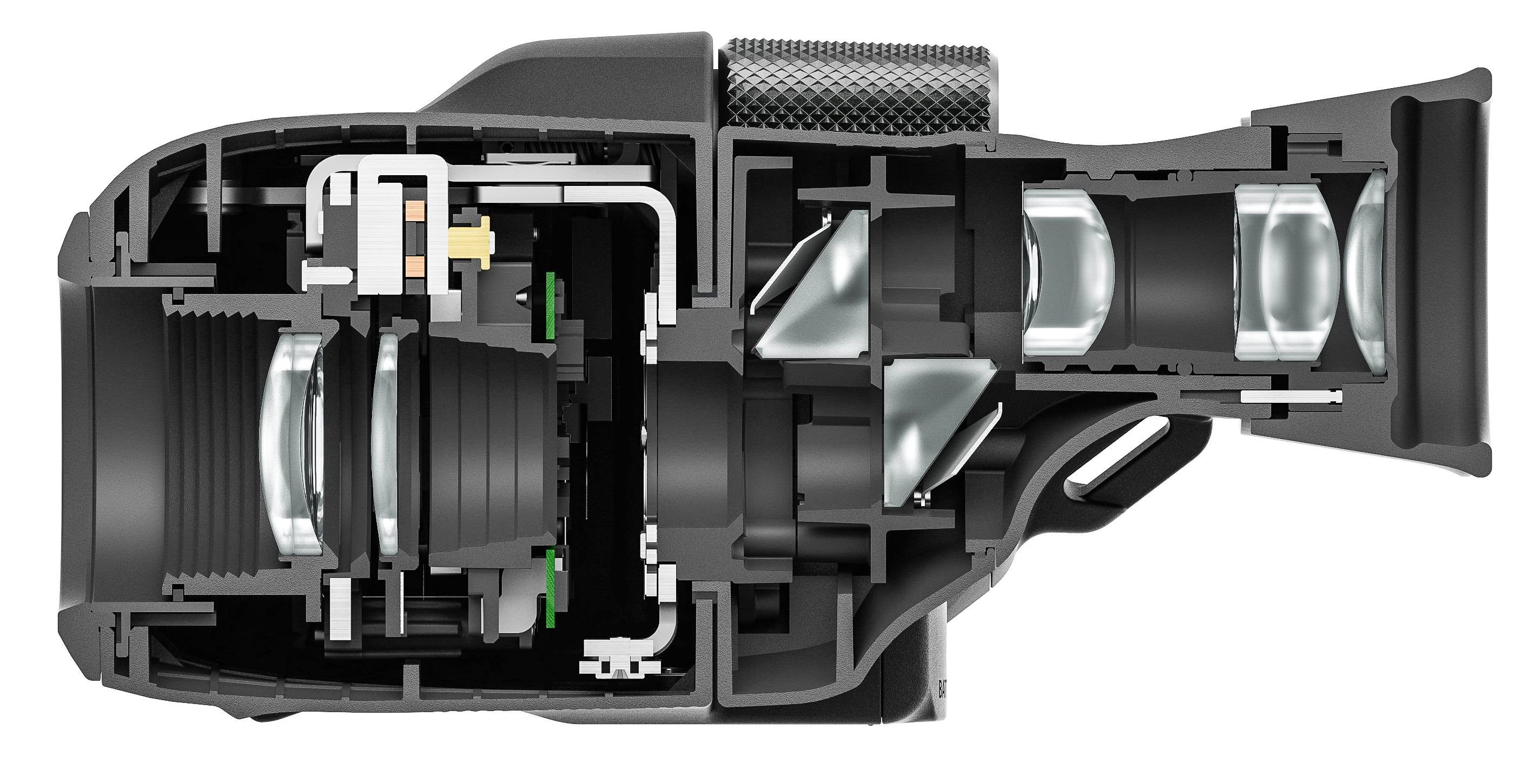
What do the numbers, such as 10x42, stand for on binoculars?
Binoculars are typically labeled with two numbers, like 10x42 or 8x20. These numbers refer to the magnification and the lens size, respectively.
For example, with a 10x42 pair, you have binoculars with 10x magnification and a 42mm lens diameter. While it's tempting to opt for binoculars with the highest magnification, doing so can make them larger and narrow your field of view, making it more difficult to spot certain subjects. Additionally, higher magnification makes it harder to keep the image steady, which is where image stabilization becomes even more valuable.
The second number represents the objective lens size—the larger the lens, the brighter the image, which is especially helpful in low-light conditions.
Ultimately, it's the combination of these two numbers that determines how bright the image will be. If you divide the lens size by the magnification, you get the "exit pupil size." For example, with 8x20 binoculars, the exit pupil is 2.5, while with 10x42 binoculars, it’s 4.2. If you frequently use your binoculars in low light (like at dusk), look for a pair with an exit pupil ratio of 4 or higher for optimal brightness.
Get the Digital Camera World Newsletter
The best camera deals, reviews, product advice, and unmissable photography news, direct to your inbox!

For nearly two decades Sebastian's work has been published internationally. Originally specializing in Equestrianism, his visuals have been used by the leading names in the equestrian industry such as The Fédération Equestre Internationale (FEI), The Jockey Club, Horse & Hound, and many more for various advertising campaigns, books, and pre/post-event highlights.
He is a Fellow of the Royal Society of Arts, holds a Foundation Degree in Equitation Science, and holds a Master of Arts in Publishing. He is a member of Nikon NPS and has been a Nikon user since his film days using a Nikon F5. He saw the digital transition with Nikon's D series cameras and is still, to this day, the youngest member to be elected into BEWA, the British Equestrian Writers' Association.
He is familiar with and shows great interest in 35mm, medium, and large-format photography, using products by Leica, Phase One, Hasselblad, Alpa, and Sinar. Sebastian has also used many cinema cameras from Sony, RED, ARRI, and everything in between. He now spends his spare time using his trusted Leica M-E or Leica M2, shooting Street/Documentary photography as he sees it, usually in Black and White.
